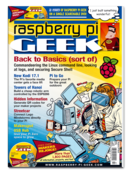Using a Raspberry Pi to synchronize data
The old Microsoft motto of "a PC on every desk" has been obsolete for a while now. In fact, the myriad of intelligent devices is ever increasing in size. As a consequence, the need for data exchange solutions is growing as well. In today's world, the magic phrase is data synchronization. An important issue in synchronization is that there are many possible connections among just five devices, such as a server, desktop, laptop, tablet, and smartphone. Thus, it makes sense to have a central synchronization server replace point-to-point connections so that data exchange from one device to another can occur asynchronously (Figure 1).
Access to the hub is always available, but not access to the individual devices. Moreover, you don't have to deal with different connections, and the devices don't have to go online at the same time for an exchange of data to take place. The data exchange hub therefore should run on a computer that is as efficient as possible in terms of power and heat generation. As a mini-PC, the Raspberry Pi is ideal for serving as a foundation upon which to build a home synchronization server. (See the box called "How Much Server Is Needed?")
An Alternative to Dropbox?
Dropbox has become almost synonymous with the notion of cross-platform data synchronization. For those who don't want to hand over the task of synchronization to a host provider, freeware alternatives like ownCloud [1] or Seafile [2] can be used. Both of these solutions run on the Raspberry Pi [3] as well. However, the Dropbox model of keeping all data on all participating devices synchronized is not always a suitable solution.
[...]
Buy this article as PDF
Pages: 8
(incl. VAT)







